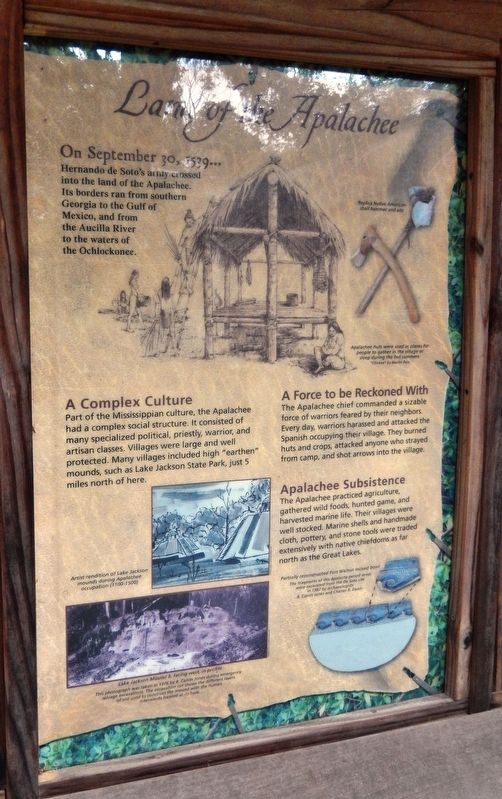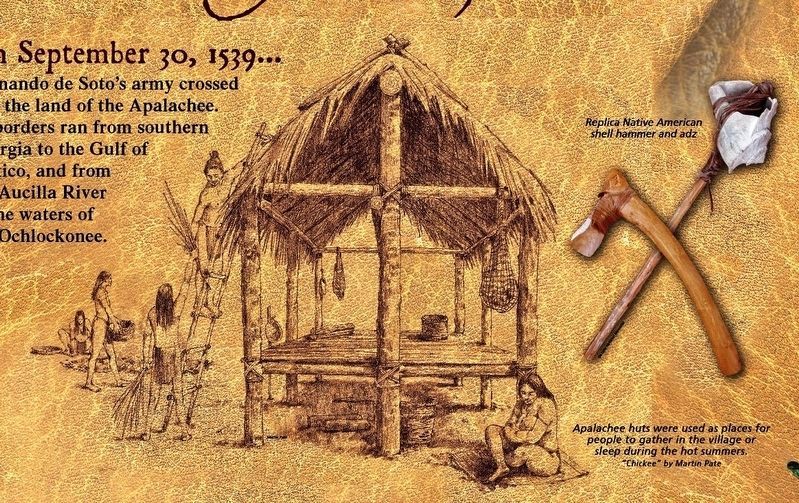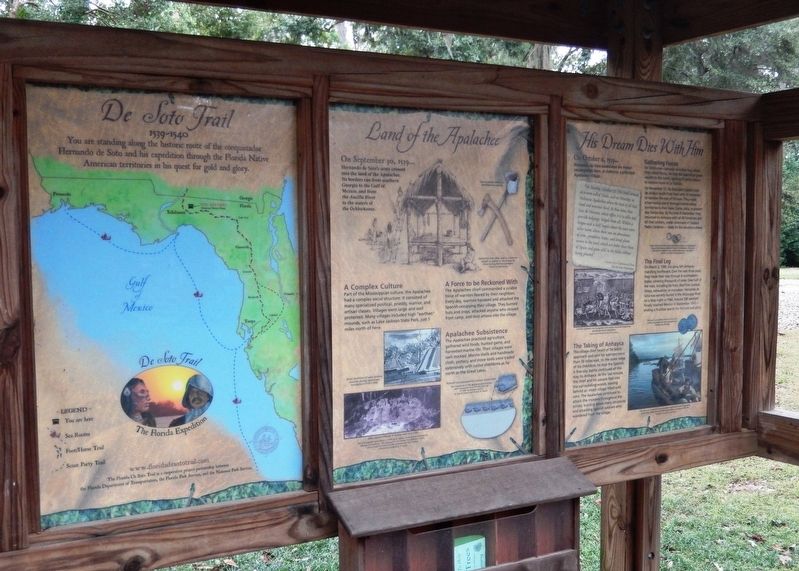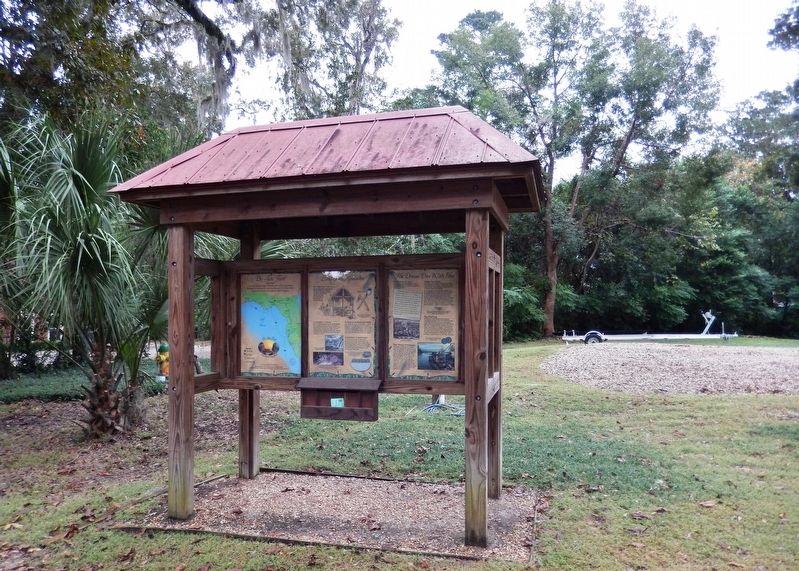Woodland Drives in Tallahassee in Leon County, Florida — The American South (South Atlantic)
Land of the Apalachee
Florida De Soto Trail
— September 30, 1539 —
Hernando de Soto’s army crossed into the land of the Apalachee. Its borders ran from southern Georgia to the Gulf of Mexico, and from the Aucilla River to the waters of the Ochlockonee.
A Complex Culture
Part of the Mississippian culture, the Apalachee had a complex social structure. It consisted of many specialized political, priestly, warrior and artisan classes. Villages were large and well protected. Many villages included high “earthen” mounds, such as Lake Jackson State Park, just 5 miles north of here.
A Force to be Reckoned With
The Apalachee chief commanded a sizable force of warriors feared by their neighbors. Every day, warriors harassed and attacked the Spanish occupying their village. They burned huts and crops, attached anyone who strayed from camp, and shot arrows into the village.
Apalachee Subsistence
The Apalachee practiced agriculture, gathered wild foods, hunted game, and harvested marine life. Their villages were well stocked. Marine shells and handmade cloth, pottery, and stone tools were traded extensively with native chiefdoms as far north as the Great Lakes.
Erected by Florida De Soto Trail, Florida Department of Transportation, the Florida Park Service, and the National Park Service. (Marker Number 29b.)
Topics. This historical marker is listed in these topic lists: Colonial Era • Exploration • Native Americans • Notable Events. A significant historical date for this entry is September 30, 1539.
Location. 30° 26.159′ N, 84° 16.115′ W. Marker is in Tallahassee, Florida, in Leon County. It is in Woodland Drives. Marker is on Desoto Park Drive south of East Lafayette Street, on the left when traveling south. Kiosk and marker are located on the grounds of the DeSoto Site Historic State Park, on the east side of the road as you approach the parking lot. Touch for map. Marker is at or near this postal address: 1001 Desoto Park Drive, Tallahassee FL 32301, United States of America. Touch for directions.
Other nearby markers. At least 8 other markers are within walking distance of this marker. His Dream Dies With Him (here, next to this marker); De Soto Winter Encampment Site 1539~1540 (a few steps from this marker); Governor John W. Martin House (within shouting distance of this marker); Myers Park Historic District (approx. 0.4 miles away); Old Fort Park (approx. 0.4 miles away); Korean War Memorial (approx. 0.4 miles away); a different marker also named Old Fort Park (approx. half a mile away); Modern Tallahassee (approx. half a mile away). Touch for a list and map of all markers in Tallahassee.
More about this marker. Marker is a large, composite plaque
mounted vertically within a heavy-duty wooden kiosk. This marker is the center panel of a three-panel kiosk.
Regarding Land of the Apalachee. Hernando de Soto landed at Tampa Bay in 1539 and made his way north in search of gold and riches. A controversial figure in American history, Spanish Conquistador Hernando de Soto is regarded as a hero and brave explorer by some — and an overzealous madman by others. The De Soto Trail shows him as a product of Medieval Europe, a brutal society forged over 780 years of warfare. It also tells the story
of the Native American peoples of 16th-century Florida, a highly advanced collection of chiefdoms struggling against each other to gain dominance over their regions.
Related markers. Click here for a list of markers that are related to this marker. Florida De Soto Trail
Also see . . .
1. The Apalachees of Northwest Florida. From at least A.D. 1000, a group of farming Indians was living in northwest Florida. They were called the Apalachees. Other Florida Indians regarded them as being wealthy and fierce. Prior to European contact, there were probably at least 50,000-60,000 Apalachees. They were a strong and powerful chiefdom living in widely dispersed villages. Their leaders organized their work, and much of their social, ritual and political life as well. Other tribes respected the Apalachees because they
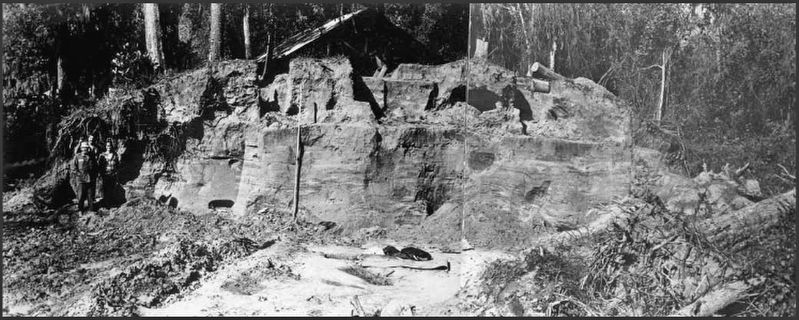
Florida Division of Historical Resources, November 14, 2018
3. Marker detail: Lake Jackson Mound 3, facing west, in profile
This photograph was taken in 1976 by B. Calvin Jones during emergency salvage excavations. The excavation cut shows the different layers of soil used to construct the mound with the human interments located at its base.
2. De Soto’s Expedition to North America. In 1536, de Soto obtained a royal commission to conquer and settle the region known as La Florida (now the southeastern United States), which had been the site of earlier explorations by Juan Ponce de León and others. De Soto set out from Spain in April 1538, set with 10 ships and 700 men. After a stop in Cuba, the expedition landed at Tampa Bay in May 1539. They moved inland and eventually set up camp for the winter at a small Indian village near present-day Tallahassee. (Submitted on November 16, 2018, by Cosmos Mariner of Cape Canaveral, Florida.)
3. Apalachee People. They were ultimately subdued about 1600 and missionized by Spanish Franciscans. They continued to prosper (in 1655, 6,000–8,000 Apalachee occupied eight towns, each with a Franciscan mission) until early in the 18th century when Creek tribes to the north, incited by the British, began a series of raids on Apalachee settlements. These attacks culminated in 1703 when an army made up of a few hundred Englishmen and several thousand Creek warriors defeated the combined Spanish and Apalachee. The tribe was almost totally destroyed,
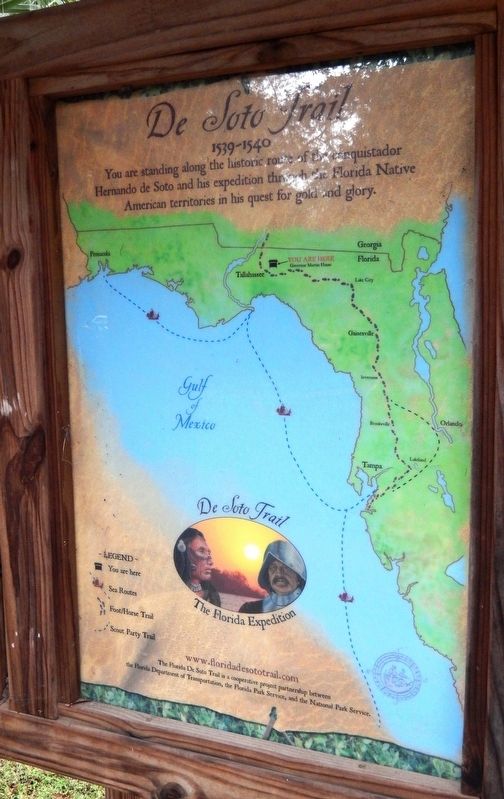
Photographed By Cosmos Mariner, November 14, 2018
4. Florida De Soto Trail Map (panel to the left of marker in kiosk)
1539-1540
Credits. This page was last revised on February 12, 2023. It was originally submitted on November 16, 2018, by Cosmos Mariner of Cape Canaveral, Florida. This page has been viewed 546 times since then and 42 times this year. Last updated on November 21, 2018, by Cosmos Mariner of Cape Canaveral, Florida. Photos: 1, 2, 3, 4, 5, 6. submitted on November 16, 2018, by Cosmos Mariner of Cape Canaveral, Florida. • Bernard Fisher was the editor who published this page.
